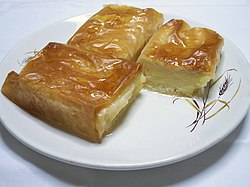Top Qs
Timeline
Chat
Perspective
Galaktoboureko
Custard-filled pastry From Wikipedia, the free encyclopedia
Remove ads
Galaktoboureko (Greek: γαλακτομπούρεκο, Laz: paponi, Turkish: laz böreği) is a dessert popular in Greece[5] and the eastern Black Sea Region of Turkey.[1][2] It is made of custard, layers of filo dough and covered in syrup.[6] Galaktoboureko is made with a type of pudding called muhallebi or semolina custard. In Albania, it is a dessert sometimes prepared during the Orthodox Easter, although Qumështor, an Albanian custard that includes no filo dough is traditionally preferred.[7][8]
Remove ads
Preparation
Galaktoboureko may be made in a pan, with filo layered on top and underneath (20 layers in total)[5] and cut into square portions, or rolled into individual servings (often approximately 10 cm (4 in) long). It is served or coated with a clear, sweet syrup. The semolina custard, or milk rice (muhallebi) may be flavored with lemon, orange, or rose. Unlike mille-feuille, which it only vaguely resembles, the custard is baked with the pastry,[9] not added afterwards. It is popular across Greece, with regional and local variations in ingredients and preparation. Notable versions are associated with Athens and Thessaloniki.[5][10][page needed]
Laz böreği/Paponi is made with a variation of the pudding called muhallebi with the inclusion of cornmeal and ground black pepper, instead of semolina custard. It is popular in the Rize and Artvin provinces in the Black Sea Region, indigenous Laz land.[1][2] Its ingredients are thin filo dough, butter, muhallebi, black pepper and simple syrup.
Remove ads
History

The earliest known references to this dessert date back to the Byzantine period, highlighting the historical importance of milk and semolina in ancient Mediterranean culinary traditions.[5][better source needed] Ancient Greek cuisine included a similar dish called plakous, made with honey, cheese, and wheat. Filo entered Greek cuisine later, during the Ottoman period.[11][12]
The Turkish version of the dessert was registered in 2019 as a geographical indication by the Turkish Patent and Trademark Office under the name "Hopa Laz Böreği".[13][14]
Remove ads
See also
References
External links
Wikiwand - on
Seamless Wikipedia browsing. On steroids.
Remove ads

